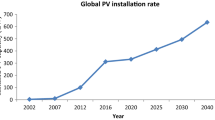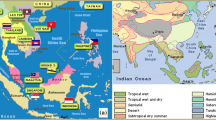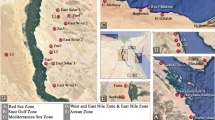Abstract
While solar energy can be utilized for passive space heating, efficient passive space cooling is achievable through lower temperature ambient thermal sources. In this study, a model was proposed for the combined solar heating and radiative cooling and a MATLAB code is developed to simulate combined space heating and cooling of a small building in Louisville, Kentucky. The combined system consists of the glazing/transparent insulation subsystem and the thermal storage subsystem. The space is passively heated and cooled by means of natural convection from the surfaces of the storage subsystem where the storage tank is heated by solar radiation and cooled by night sky radiation as a low temperature thermal source. The model for this system consists of several transient energy balance equations based on the lumped capacitance approach and it has been implemented utilizing MATLAB. Using the aforementioned system and the auxiliary heating/cooling units, the room temperature can be kept within the prescribed comfort range. The simulation is carried out to find the monthly and annual solar fraction, required heating demand, auxiliary heating demand as well as the unwanted heat gain during heating months. Also, the radiative cooling fraction, required cooling demand and auxiliary cooling demand during cooling months are obtained. The optimum value for transparent layer absorptivity was found to avoid unwanted heat gain. Parametric sensitivity was evaluated for material and design features related to the combined system. Simulation results for temperature profiles of the room and storage tank are also illustrated.
Similar content being viewed by others
Abbreviations
- A a :
-
area of aperture (m2)
- A i :
-
anisotropy index
- A s :
-
surface area (m2)
- C b :
-
effective thermal capacitance (J/K)
- C cover :
-
cloudiness factor
- C p,n :
-
specific heat of the n-th node (J/(kg·K))
- ET:
-
equation of time
- G n :
-
rate of heat transfer with external source at the n-th node (W)
- G sc :
-
solar constant (W/m2)
- h w :
-
wind heat transfer coefficient (W/(m2·K))
- I :
-
global horizontal irradiance (W/m2)
- I 0 :
-
irradiance at surface (W/m2)
- I b :
-
beam horizontal irradiance (W/m2)
- I d :
-
diffuse horizontal irradiance (W/m2)
- I o :
-
horizontal irradiance in the absence of the atmosphere (W/m2)
- I r :
-
irradiance at distance x (W/m2)
- I T :
-
total irradiance on tilted surface (J/m2)
- I Tc :
-
critical radiation level (W/m2)
- k nm :
-
thermal conductance between the nodes m and n (W/K)
- k r,a :
-
radiative heat transfer coefficient for the radiation to the ambient
- k r,s :
-
radiative heat transfer coefficient for the radiation to the sky
- l :
-
longitude
- l st :
-
local standard time (hr)
- L :
-
characteristics length (m)
- L h :
-
cube root of the house volume (m3)
- m n :
-
mass of n-th node (kg)
- n :
-
node number; number of day
- n a :
-
index of refraction for air
- n g :
-
index of refraction for glass
- N :
-
number of covers
- Nu :
-
Nusselt number
- P :
-
perimeter (m)
- Pr :
-
Prandtl number
- Q abs :
-
absorbed energy in the system (J/m2)
- Q̄ abs :
-
monthly absorbed energy in the system (J/m2)
- Q aux,c :
-
auxiliary cooling energy (J/m2)
- Q aux,h :
-
auxiliary heating energy (J/m2)
- Q D :
-
dump energy (J/m2)
- Q f :
-
absorbed energy in transparent layer with variable filter (J/m2)
- Q r :
-
direct solar heating energy (J/m2)
- Q̄ rad :
-
monthly radiation on the aperture (J/m2)
- Q rem :
-
storage tank removal energy (J/m2)
- Q req,c :
-
cooling demand (J/m2)
- Q req,h :
-
heating demand (J/m2)
- Q s :
-
direct thermal storage in the water tank (J/m2)
- Q uwg :
-
unwanted solar gain (J/m2)
- r ‖ :
-
parallel component of the unpolarized radiation
- r ⊥ :
-
perpendicular component of the unpolarized radiation
- R B :
-
beam radiation tilt factor
- Ra L :
-
Rayleigh number
- RF:
-
radiative fraction
- RUS:
-
ratio of unwanted gain to solar gain
- SF:
-
annual solar fraction
- SF0 :
-
solar fraction for zero-capacitance building
- SF∞ :
-
solar fraction for infinite-capacitance building
- SFj :
-
monthly solar fraction
- Δt :
-
simulation step time (s)
- T a :
-
absorber temperature (K)
- T amb :
-
ambient temperature (K)
- T c :
-
transparent cover temperature (K)
- T d :
-
dew point temperature (K)
- T H :
-
upper comfort limit (K)
- T L :
-
lower comfort limit (K)
- T n :
-
temperature of the n-th node (K)
- T sky :
-
effective sky temperature (K)
- ΔT b :
-
difference between upper and lower comfort temperatures (K)
- UWG:
-
unwanted gain fraction
- V :
-
wind speed (m/s)
- X :
-
solar load ratio
- Y :
-
storage dump ratio
- α :
-
absorptivity
- α f :
-
absorptivity of the transparent layer with variable filter
- α n :
-
absorptivity at normal incidence
- β :
-
collector tilt (°)
- δ :
-
declination (°)
- ɛ 0 :
-
emissivity of clear sky
- ɛ a :
-
absorber emissivity
- ɛ c :
-
cover emissivity
- ϕ :
-
latitude (°)
- γ :
-
surface azimuth angle (°)
- φ̄:
-
monthly average utilizability
- µ:
-
coefficient of extinction (m−1)
- θ b :
-
angle of incidence (°)
- θ d :
-
effective incidence angle of isotropic diffuse radiation (°)
- θ g :
-
effective incidence angle of ground-reflected radiation (°)
- θ r :
-
angle of refraction (°)
- θ z :
-
zenith angle (°)
- ρ g :
-
ground reflectivity
- τ :
-
transmittance
- τ a :
-
transmittance in regard with absorption losses only
- τ r :
-
transmittance based on the refraction losses only
- (τα):
-
transmittance-absorptance product
- τ̄ᾱ:
-
monthly average transmittance-absorptance product
- ω :
-
hour angle (°)
- Ω a :
-
percentage of solid angle for ambient
- Ω s :
-
percentage of solid angle for sky
- b:
-
beam
- d:
-
diffuse
- g:
-
ground-reflected
- old:
-
value at previous iteration
References
Brownson JRS (2014). Solar Energy Conversion Systems. Oxford, UK: Academic Press.
Byrne P, Miriel J, Lenat Y (2009). Design and simulation of a heat pump for simultaneous heating and cooling using HFC or CO2 as a working fluid. International Journal of Refrigeration, 32: 1711–1723.
Byrne P, Miriel J, Lénat Y (2012). Modelling and simulation of a heat pump for simultaneous heating and cooling. Building Simulation, 5: 219–232.
Çengel YA, Ghajar AJ (2014). Heat and Mass Transfer: Fundamentals and Applications, 5th edn. New York: McGraw-Hill.
Chan HY, Riffat SB, Zhu J (2010). Review of passive solar heating and cooling technologies. Renewable and Sustainable Energy Reviews, 14: 781–789.
Dai Q, Fang X (2014). A new model for atmospheric radiation under clear sky condition at various altitudes. Advances in Space Research, 56: 1044–1048.
Duffie JA, Beckman WA (2013). Solar Engineering of Thermal Processes, 4th edn. New York: John Wiley & Sons.
Hanif M, Mahlia TMI, Zare A, Saksahdan TJ, Metselaar HSC (2014). Potential energy savings by radiative cooling system for a building in tropical climate. Renewable and Sustainable Energy Reviews, 32: 642–650.
Henning HM (2007). Solar assisted air conditioning of buildings-An overview. Applied Thermal Engineering, 27: 1734–1749.
Henning HM, Döll J (2012). Solar systems for heating and cooling of buildings. Energy Procedia, 30: 633–653.
Kasten F, Czeplak G (1980). Solar and terrestrial radiation dependent on the amount and type of cloud. Solar Energy, 24: 177–189.
Leo Samuel DG, Nagendra SM, Maiya MP (2013). Passive alternatives to mechanical air conditioning of building: A review. Building and Environment, 66: 54–64.
Martin M, Berdahl P (1984). Characteristics of infrared sky radiation in the United States. Solar Energy, 33: 321–336.
Robinson BS, Dorwart J, Sharp MK (2013). US space cooling potentials for ambient sources with thermal energy storage. International Journal of Ambient Energy, doi:10.1080/01430750.2013.864585.
Sameti M (2014). Electrical energy efficient building through distributed generation. International Journal of Renewable Energy Research, 4: 777–783.
Santamouris M, Kolokotsa D (2013). Passive cooling dissipation techniques for buildings and other structures: The state of the art. Energy and Buildings, 57: 74–94.
Wang J, Wu J, Zheng C (2014). Analysis of tri-generation system in combined cooling and heating mode. Energy and Buildings, 72: 353–360.
Wu W, You T, Wang B, Shi W, Li X (2014). Simulation of a combined heating, cooling and domestic hot water system based on ground source absorption heat pump. Applied Energy, 126: 113–122.
Author information
Authors and Affiliations
Corresponding author
Rights and permissions
About this article
Cite this article
Sameti, M., Kasaeian, A. Numerical simulation of combined solar passive heating and radiative cooling for a building. Build. Simul. 8, 239–253 (2015). https://doi.org/10.1007/s12273-015-0215-x
Received:
Revised:
Accepted:
Published:
Issue Date:
DOI: https://doi.org/10.1007/s12273-015-0215-x




